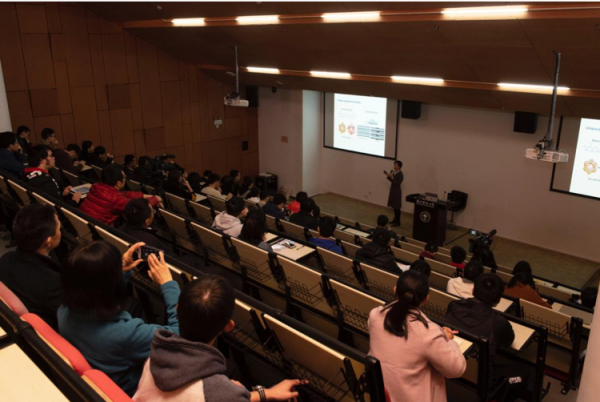Southern University of Science and Technology (SUSTech) welcomed the Academician Yu Jihong from the Chinese Academy of Sciences to campus last week. She came to give the 203rd lecture in the SUSTech Lecture Series. Yu Jihong lectured about “Design and Construction of Molecular Sieve Nanoporous Materials.” The lecture was hosted by fellow academician Yu Dapeng of the Department of Physics and the Shenzhen Institute of Quantum Science and Engineering.

Yu Jihong is an academician of the Chinese Academy of Sciences and director of the Joint Laboratory of Future Science International Cooperation of Jilin University. She is also the director of the Molecular Sieves Professional Committee of the Chinese Chemical Society and the academic leader of the Innovation Research Group of the National Natural Science Foundation of China. Yu Jihong is also in charge of the plan of innovation of academic disciplines in institutions of higher education.
During her lecture, Yu Jihong spoke about the extensive applications of molecular sieve nanoporous materials in fields closely related to energy and environmental protection, using clear language. She compared nanoporous materials to buildings with space and corridor passages that are invisible to the naked eye.
Molecular sieves are used to screen molecules of different sizes, properties, and shapes through internal regular “corridor passages.” It can also deal with ion exchange and selective catalysis. This means that molecular sieve nanoporous materials have important industrial applications in ion exchange, adsorption separation, and catalysis.
Yu Jihong talked about how to establish a database through system synthesis. She summarized the rules, established theories and methods, and realized the directional design and synthesis of molecular sieve nanoporous materials. The proposed Local Interatomic Distances (LID) rules for structural screening were used for structural screening, further absorption, and catalytic performance prediction. This example provided theoretical guidance for experimental synthesis.
Yu Jihong went into depth for her team’s nucleation mechanism for hydroxyl radical accelerated molecular sieves. Her team introduced photoactive hydroxyl radicals into the synthesis system of zeolites to accelerate their crystallization process. Yu Jihong developed a directional synthesis method of molecular sieve nanoporous materials. Through combinatorial chemistry and high throughput screening, a series of molecular sieve nanoporous materials and their composites with excellent catalytic performance, separation, and host-guest assembly were designed and synthesized.
In the final stages of her lecture, Yu Jihong explained how molecular sieve nanoporous materials could be applied in energy-saving catalytic processes, environmentally friendly absorption, waste and energy storage, and bio-related fields. Molecular sieves also play an increasingly important role in sustainable chemical development, such as the improvement of renewable energy. This is particularly the case in areas such as development of new bioenergy and fuel cells, the storage of thermal energy, the catalytic conversion of carbon dioxide, the treatment of air pollutants and sewage, and seawater desalinton.
Yu Jihong took numerous questions from students and faculty members after her lecture in a vigorous Q&A session.
Proofread ByXia Yingying
Photo ByHan Wei